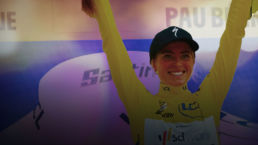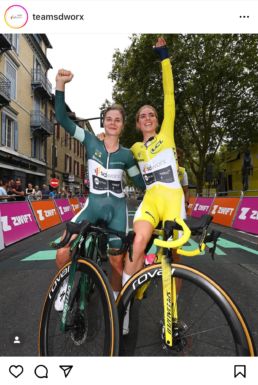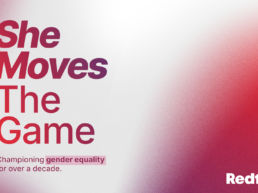The Tour de France Femmes (TDFF) is over, and a new champion crowned, so it’s the perfect opportunity to explore how popular this year’s Tour has been across social media – and look at what needs to be done to help women’s pro cycling grow as we look to the future.
That’s where the SportOnSocial Tour de France Femmes 2023 League Table comes in. It analyses the event, and the teams and riders who performed best on the digital road.
The results? A generally positive outlook for women’s pro cycling!
The TDFF social media accounts saw an overall 72.5k follower growth/2.7m engagements during the race. Teams gained a combined 91.7k new followers (to a total of almost 7.3m) and generated 1.5m engagements/1.2m video views.
And all this while competing for attention against other major sporting events, e.g. FIFA Women’s World Cup, the World Aquatics Championships.
The public profiles of individual riders are on the increase, too (a combined total of 131.1k new followers); overall winner Demi Vollering alone secured 25.3k new followers. In reality, however, the pace of growth could be much greater and need not be dominated by just a few big names. A mere 18 riders, for example, achieved over 1k new followers whereas the Tour de France had 50 male riders over this figure.
The question is, do any of the numbers in the TDFF come close to those seen from during the men’s Tour? No, they don’t … but they do show progress.
The Tours themselves are obviously different for various reasons: 8 stages in the women’s compared with 21 in the men’s, for instance. So, it’s time to stop comparing like for like and learn to appreciate each on their own merit. This means putting a stop to looking at the shortcomings in women’s cycling – such as smaller audiences – and look instead at what makes it unique, at its key selling points for potential audiences and sponsors alike.
You only have to glance over the comments on a few social posts about any women’s sport to know that not everyone is open to hearing about it. It’s common knowledge that the audience demographic watching women’s sports differs to that watching men’s.
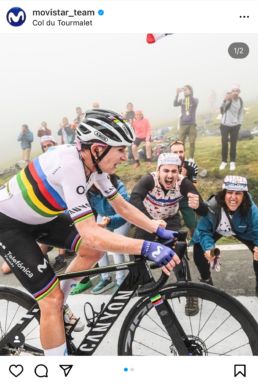
Just take a look at Movistar Team which has combined social media accounts for the men’s and women’s teams. It was the one team that recorded negative fan growth throughout the TDFF this year yet they sat in the top 10 for fan growth during the men’s Tour de France. Perhaps this is because some of their fans simply don’t want to see content from the women’s sport on their feeds, and that’s fair enough.
But there is a large demographic out there who do want to consume women’s cycling.
TV viewership figures from this year’s race back this up. Eurosport’s coverage had a viewer reach of nearly 15m (+7.14% vs 2022); France Télévisions attracted a total viewership of nearly 20 million: Tour videos on the broadcaster’s streaming and online platforms gained 1.3m views (+8% vs 2022).
An excellent example of how women’s cycling teams have succeeded away from the men is highlighted in the SportOnSocial Tour de France Femmes 2023 report. The two best-performing teams on social media – Canyon//SRAM Racing and Team SD Worx – are both women’s-only teams (i.e. they don’t have a men’s pro team with the same name). They not only held their own against, but also outperformed the likes of Team Jumbo–Visma and Movistar Team which might even be seen to have the advantage of pre-existing brand strength from their men’s teams and mixed-gender accounts across some, if not all, platforms.
Having an instantly recognisable brand is invaluable and mixed-gender teams should absolutely maximise the use of their distinctive brand assets (e.g. names/colours) that are well-known in men’s cycling. But they can (and should) do this through their own separate accounts and their own voices.
Will their follower/engagement numbers of the women’s teams be lower than their male counterparts for now? Potentially. Will the followers they do have be truly engaged and excited to see content about women’s sport? Absolutely.
Having separate accounts gives a much clearer picture of the demographic of women’s cycling fans which is extremely useful for the teams and for potential sponsors. Sure, many sponsors might rather invest in a men’s team with a larger viewership, but some may actually benefit from a more targeted approach.
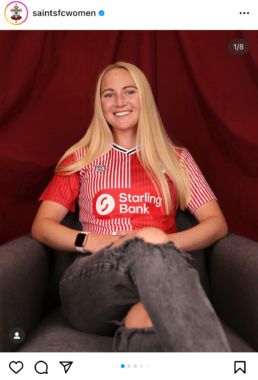
Take an example from another sport. Starling Bank has seen great success through its sponsorship of Southampton Football Club’s women’s team and has extended the partnership for a further 3 years. They want to push their family products, including children’s bank accounts, and the women’s team’s fan base is better suited for promoting this than the men’s, despite being much smaller.
Women’s cycling can learn from this. It’s often repeated in marketing, but it’s absolutely essential to know your audience. We need to be asking what makes the women’s pro cycling audience distinct from the men’s and which brands can benefit from this? Then you have an appealing product that in turn brings more funding to the women’s sport.
Indeed, how can cycling teams with mixed-gender social media accounts really know who of their followers are women’s cycling fans? Those that are surely won’t think twice about following a second account for more tailored content.
Teams that adopt the approach of having separate accounts can learn from those of the Tour de France and Tour de France Femmes in terms of successful cross-account promotion on Instagram. They’ve done this extremely well this year through collaborating on some (although not all) posts to maximise reach.
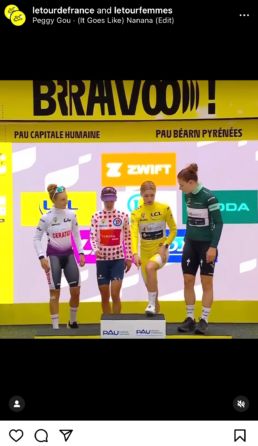
My advice? Give men’s cycling fans a small amuse bouche of what they may be missing and direct them to the women-specific accounts for more content.
The future is clearly bright for women’s cycling, and the men’s sport can play its part along the way, but in general it’s time to let women’s cycling stand on its own two wheels. Women’s teams shouldn’t be seen as a less valuable bolt-on to a men’s team but as a valuable product in their own right.
So, give the teams their own voices and let’s show the world exactly why the sport of women’s cycling is such an exciting sport to watch!
Rozie Fuller
Hi, I’m Rosie. A football mad, crazy horse lady… a rare species! Spend most of my life on social media to keep up with the latest news and hottest trends.
My most memorable sporting moment is …
My first ever trip to Old Trafford to watch Manchester United play (despite the fact we lost).
I am happiest when …
Spending time outside with my horse… even in the rain!
The sports person that best represents me is …
John Whitaker – always calm and collected under pressure.
The three things at the top of my bucket list are …
1. Go on a horseback safari
2. Get a dog of my own
3. Watch England lift a major international football trophy
A quote I try to live my life by is …
“I don’t do stress… it gives you wrinkles” - Me


